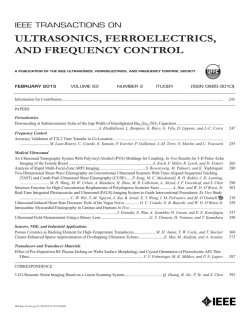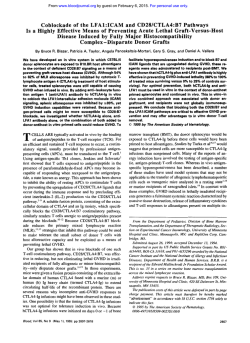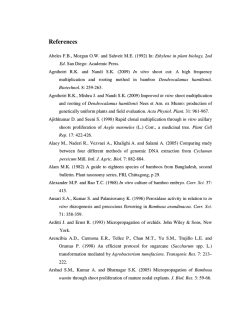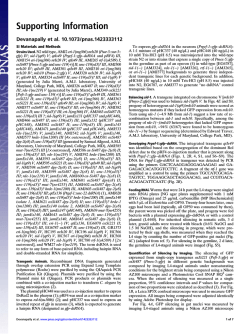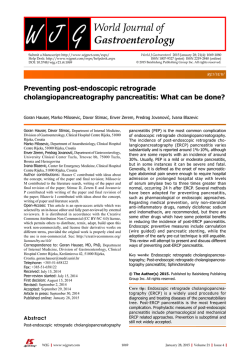
1-s2.0-S1072751514008667-main
S138 Surgical Forum Abstracts activation and induced antitumor effects in patients with pancreatic cancer. Therefore, we hypothesized that NM downregulates the radiation-induced activation of NF-kB and improves therapeutic outcome of pancreatic cancer. METHODS: In vitro, we assessed NF-kB activity, induction of caspase cascade, and cell proliferation using human pancreatic cancer cell lines (PANC-1, MIA PaCa-2) treated with radiation (6Gy) alone, NM alone, and combination of radiation and NM. In vivo, we established xenograft pancreatic cancer in mice by subcutaneous injection of MIA PaCa-2 cells. At 5 weeks after injection, the tumor was irradiated (6Gy) once (radiation group), with i.p. injection of NM 3 times a week (NM group), or with combination of radiation once and NM 3 times a week (combination group). RESULTS: In combination group, NF-kB activation was significantly inhibited in comparison with that of radiation group both in vitro and in vivo (p<0.05). Cleaved caspase-3, 8, and 9 levels were the highest in the combination group both in vitro and in vivo. In combination group, cell proliferation and tumor growth were significantly slower than those in other groups (p<0.05) both in vitro and in vivo. CONCLUSIONS: Combination therapy of radiation with NM exertrs enhanced anti-tumor effect against human pancreatic cancer. Combination of Small RNAs Enhances Muscle Development John R Jackson, PhD, NaJung Kim, PhD, James Yoo, MD, PhD, Sang Jin Lee, Anthony Atala, MD, FACS Wake Forest School of Medicine, Winston-Salem, NC INTRODUCTION: Selectively controlling the expression of the target genes through small RNAs has significant potential for treatment of numerous injuries and diseases. We introduced combinations of multiple small RNAs to direct the production of various cellular factors, to promote in situ muscle tissue regeneration in a targeted site. We expect this novel combination of small RNAs would enhance muscle recovery and regeneration. METHODS: To evaluate the myogenic potentials of small RNAs in vitro, we used three different small RNAs, siGDF-8, miR-1, and miR-206. Murine myoblasts were transfected with individual or combinations of the RNAs, and incubated in differentiation media until used for gene expression, proliferation, and differentiation analyses. Chemically injured Lewis rat tibialis anterior (TA) muscles were treated with RNAs and analyzed for functional and structural recovery. RESULTS: Adding siGDF-8 to these miRNAs significantly increased gene expressions of all the myogenic regulatory factors (MRFs) tested. This combination of small RNAs also enhanced myosin protein expression by miR-1 and miR-206. It also resulted in acceleration of myoblast proliferation by the action of siGDF-8. Structural and J Am Coll Surg functional recovery of hind leg was significantly accelerated by this combination delivery of siGDF-8, miR-1, and miR-206. CONCLUSIONS: Combinations of small RNAs enhanced myogenic activation by overexpressing MRFs such as MyoD, myogenin, Pax7, and MyHC1. The combination delivery also accelerated in vivo regenerative efficiency compared with the effects of any single- or two-factor mixture. This novel combination of siGDF-8, and miR-1 and miR-206 is expected to have a great therapeutic potential to fine-tune skeletal muscle recovery from traumatic injury. Multiple Injections of Oncolytic Adenoviruses Suppressed the Growth of Human Papilloma Virus (HPV)-Positive Head and Neck Squamous Cell Carcinomas in an In Vivo Model Christopher J LaRocca, MD, Amanda R Oliveira, DVM, MS, Julia Davydova, MD, PhD, Mark Herzberg, DDS, PhD, Rajaram Gopalakrishnan, BDS, PhD, Masato Yamamoto, MD, PhD University of Minnesota, Minneapolis, MN INTRODUCTION: The incidence of HPV-positive head and neck squamous cell carcinomas (HNSCC) has been steadily increasing. Oncolytic viruses are an emerging class of anti-cancer agents with great therapeutic potential. Specifically, conditionally replicative oncolytic adenoviruses (CRAds) targeted to the HPV E6 and E7 oncogenes have the ability to become a novel treatment modality for this disease. METHODS: Two CRAds (5/3 D24 and 5/3 CB016) were designed with an Ad5/Ad3 chimeric fiber to maximize infectivity and overexpression of the adenovirus death protein to increase oncolysis. Each CRAd possesses a distinct deletion (D24 or CB016) in the E1a region of the adenoviral genome which allows for selective replication in HPV-positive HNSCC cells. The viral vectors were generated and thoroughly tested in an in vitro setting. Thereafter, subcutaneous tumors were generated in the flanks of athymic nude mice using a HPV-positive HNSCC cell line (UPCI SCC 090). The tumors were then injected with one of the adenoviruses or a saline control. Three subsequent injections were performed at four-day intervals. RESULTS: Both groups (5/3 D24 and 5/3 CB016) treated with multiple injections of the oncolytic adenoviruses (3.5x1011 vp/injection) demonstrated significant reductions in tumor volume compared to the saline control group (p¼0.000001 for 5/3 D24, p¼0.0003 for 5/3 CB016) by day 23 after the initial viral inoculation. Notably, the 5/3 D24 virus’ oncolytic effect was strong enough to cause tumor regression. CONCLUSIONS: Multiple injections of oncolytic adenoviruses designed to target HPV-positive HNSCC tumors demonstrated significant anti-tumor effect in vivo and show excellent potential for clinical translation.
© Copyright 2026
